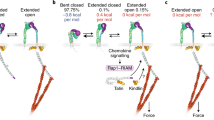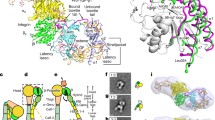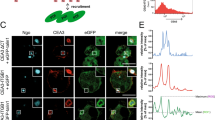Abstract
Integrins mediate cell adhesion and are essential receptors for the development and functioning of multicellular organisms. Integrin activation is known to require both ligand and talin binding and to correlate with cluster formation but the activation mechanism and precise roles of these processes are not yet resolved. Here mathematical modeling, with known experimental parameters, is used to show that the binding of a stabilizing factor, such as talin, is alone insufficient to enable ligand-dependent integrin activation for all observed conditions; an additional positive feedback is required.
Similar content being viewed by others
References
Arias-Salgado, E.G., Lizano, S., Sarkar, S., Brugge, J.S., Ginsberg, M.H., Shattil, S.J., 2003. Src kinase activation by direct interaction with the integrin beta cytoplasmic domain. Proc. Natl. Acad Sci. USA 100(23), 13298–13302.
Bell, G., 1978. Models for the specific adhesion of cells to cells. Science 200, 618–627.
Brown, N.H., Gregory, S.L., Rickoll, W.L., Fessler, L.I., Prout, M., White, R.A.H., Fristrom, J.W., 2002. Talin is essential for integrin function in Drosophila. Dev. Cell 3(4), 569–579.
Campbell, I.D., Ginsberg, M.H., 2004. The talin-tail interaction places integrin activation on FERM ground. Trends Biochem. Sci. 29(8), 429–435.
Carman, C.V., Springer, T.A., 2003. Integrin avidity regulation: Are changes in affinity and conformation underemphasized. Curr. Opin. Cell. Biol. 15(5), 547–556.
de Pereda, J.M., Wegener, K.L., Santelli, E., Bate, N., Ginsberg, M.H., Critchley, D.R., Campbell, I.D., Liddington, R.C., 2005. Structural basis for phosphatidylinositol phosphate kinase type Igamma binding to talin at focal adhesions. J. Biol. Chem. 280(9), 8381–8386.
Di Paolo, G., Pellegrini, L., Letinic, K., Cestra, G., Zoncu, R., Voronov, S., Chang, S., Guo, J., Wenk, M.R., De Camilli, P., 2002. Recruitment and regulation of phosphatidylmositol phosphate kinase type 1 gamma by the FERM domain of talin. Nature 420(6911), 85–89.
Dustin, M.L., Ferguson, L.M., Chan, P.Y., Springer, T.A., Golan, D.E., 1996. Visualization of CD2 interaction with LFA-3 and determination of the two-dimensional dissociation constant for adhesion receptors in a contact area. J. Cell Biol. 132(3), 465–474.
Faull, R.J., Kovach, N.L., Harlan, J.M., Ginsberg, M.H., 1993. Affinity modulation of integrin alpha5beta1: Regulation of the functional response by soluble fibronectin. J. Cell Biol. 121(1), 155–162.
Garcia-Alvarez, B., de Pereda, J.M., Calderwood, D.A., Ulmer, T.S., Critchley, D., Campbell, I.D., Ginsberg, M.H., Liddington, R.C., 2003. Structural determinants of integrin recognition by talin. Mol. Cell 11(1), 49–58.
Horwitz, R., Webb, D., 2003. Cell migration. Curr. Biol. 13(19), 756–759.
Hynes, R.O., 2002. Integrins: Bidirectional, allosteric signaling machines. Cell 110(6), 673–687.
Irvine, D.J., Hue, K.-A., Mayes, A.M., Griffith, L.G., 2002. Simulations of cell-surface integrin binding to nanoscale-clustered adhesion ligands. Biophys. J. 82(1 Pt 1), 120–132.
Kuo, S.C., Lauffenburger, D.A., 1993. Relationship between receptor/ligand binding affinity and adhesion strength. Biophys. J. 65(5), 2191–2200.
Li, R., Mitra, N., Gratkowski, H., Vilaire, G., Litvinov, R., Nagasami, C., Weisel, J.W., Lear, J.D., DeGrado, W.F., Bennett, J.S., 2003. Activation of integrin alphaIIbbeta3 by modulation of transmembrane helix associations. Science 300(5620), 795–798.
Ling, K., Doughman, R.L., Firestone, A.J., Bunce, M.W., Anderson, R.A., 2002. Type I gamma phosphatidylinositol phosphate kinase targets and regulates focal adhesions. Nature 420(6911), 89–93.
Martel, V., Racaud-Sultan, C., Dupe, S., Marie, C., Paulhe, F., Galmiche, A., Block, M.R., Albiges-Rizo, C., 2001. Conformation, localization, and integrin binding of talin depend on its interaction with phosphoinositides, J. Biol. Chem. 276(24), 21217–21227.
Moy, V.T., Jiao, Y., Hillman, T., Lehmann, H., Sano, T., 1999. Adhesion energy of receptor-mediated interaction measured by elastic deformation. Biophys. J. 76(3), 1632–1638.
Palecek, S.P., Loftus, J.C., Ginsberg, M.H., Lauffenburger, D.A., Horwitz, A.F., 1997. Integrin–ligand binding properties govern cell migration speed through cell-substratum adhesiveness. Nature 385(6616), 537–540.
Suehiro, K., Gailit, J., Plow, E.F., 1997. Fibrinogen is a ligand for integrin alpha5beta1 on endothelial cells. J. Biol. Chem. 272(8), 5360–5366.
Tadokoro, S., Shattil, S.J., Eto, K., Tai, V., Liddington, R.C., de Pereda, J.M., Ginsberg, M.H., Calderwood, D.A., 2003. Talin binding to integrin beta tails: A final common step in integrin activation. Science 302(5642), 103–106.
Tamkun, J.W., DeSimone, D.W., Fonda, D., Patel, R.S., Buck, C., Horwitz, A.F., Hynes, R.O., 1986. Structure of integrin, a glycoprotein involved in the transmembrane linkage between fibronectin and actin. Cell 46(2), 271–282.
van Kampen, N., 1992. Stochastic Processes in Physics and Chemistry. Elsevier Science Publishers.
Vitte, J., Benoliel A.-M., Eymeric, P., Bongrand, P., Pierres, A., 2004. Beta-1 integrin-mediated adhesion may be initiated by multiple incomplete bonds, thus accounting for the functional importance of receptor clustering. Biophys. J. 86(6), 4059–4074.
Ward, M.D., Hammer, D.A., 1994. Focal contact assembly through cytoskeletal polymerization: Steady state analysis. J. Math. Biol. 32(7), 677–704.
Wiseman, P., Brown, C., Webb, D., Hebert, B., Johnson, N., Squier, J., Ellisman, M., Horwitz, A., 2004. Spatial mapping of integrin interactions and dynamics during cell migration by Image Correlation Microscopy. J. Cell Sci. 117(Pt 23), 5521–5534.
Zamir, E., Geiger, B., 2001. Molecular complexity and dynamics of cell-matrix adhesions. J. Cell Sci. 114(Pt 20), 3583–3590.
Author information
Authors and Affiliations
Corresponding author
Rights and permissions
About this article
Cite this article
Iber, D., Campbell, I.D. Integrin activation—the importance of a positive feedback. Bull. Math. Biol. 68, 945–956 (2006). https://doi.org/10.1007/s11538-005-9049-5
Received:
Accepted:
Published:
Issue Date:
DOI: https://doi.org/10.1007/s11538-005-9049-5




